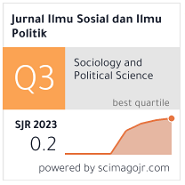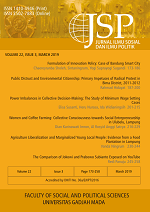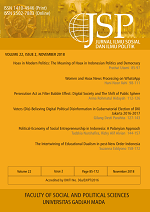Continuities of Public Service Innovations (PSIs) in Indonesia's Local Governments' Health Services: Whose Initiative Has a Higher Success Rate?
Pratiwi Pratiwi(1*), Shafiera Amalia(2), Agus Wahyuadianto(3), Masrully Masrully(4), Candra Setya Nugroho(5)
(1) National Graduate Institute for Policy Studies (GRIPS), Japan; and National Research and Innovation Agency (BRIN), Indonesia
(2) National Institute of Public Administration, Indonesia
(3) National Institute of Public Administration, Indonesia
(4) National Institute of Public Administration, Indonesia
(5) National Institute of Public Administration, Indonesia
(*) Corresponding Author
Abstract
Public Service Innovations (PSIs) have improved public services and increased public values. However, previous studies have shown that public servants saw PSIs as risky interventions because of the perceived uncertain outcomes, lack of support and recognition, opposition against incumbent culture, and negative public scrutiny in case of failure. These perceived risks have led to risk-averse behaviour in public service and incremental or discontinued innovations. Earlier studies on PSIs’ continuity have focused on leadership, engagement, collaborations, and organisational cultures in developed countries. However, the mechanism of engagements, collaborations, organisational culture, and leadership types remains unclear. This study aims to investigate the characteristics of sustainable PSIs in Indonesia and how authorities are exercised. In doing so, 11 PSIs in Indonesian health services—facilitated by staff or leaders—are compared and contrasted. The findings indicate that staff-initiated PSIs are prompted by community needs, use routine visits as a collaboration mechanism, and engage more stakeholders. The shortcoming is that the staff-initiated PSIs need more formal team assignments. The advantage is that they strengthen social capital and decrease community health problems. On the other hand, PSIs that were initiated by formal leaders are stimulated by formal antecedents, such as low achievement of development targets. Leaders-initiated PSIs also use capacity development programs to collaborate and increase the achievement of development targets. A novel finding to add to previous studies is that collaborating with other existing programs contributes to PSIs’ continuity. The managerial implication of this study is to stimulate front-liners in initiating PSIs.
Keywords
Full Text:
PDFReferences
Aberdeen, T. (2013). Yin, R. K. (2009). Case study research: Design and methods (4th Ed.). Thousand Oaks, CA: Sage. The Canadian Journal of Action Research, 14(1). https://doi.org/10.33524/cjar.v14i1.73
Afandi, M. N., & Dawud, J. (2019). Regional Innovation Strategies in Improving Public Services: A case study of Garut District. https://doi.org/10.2991/icas-19.2019.112
Alter, R. (2016). “Public-sector innovation in Indonesia”, in Open Government in Indonesia. https://doi.org/http://dx.doi.org/10.1787/9789264265905-10-en
Boons, F., Montalvo, C., Quist, J., & Wagner, M. (2013). Sustainable innovation, business models and economic performance: An overview. Journal of Cleaner Production, 45. https://doi.org/10.1016/j.jclepro.2012.08.013
Borins, S. (2000). Loose cannons and rule breakers, or enterprising leaders? Some evidence about innovative public managers. Public Administration Review, 60(6). https://doi.org/10.1111/0033-3352.00113
Borins, S. F. (2014). The persistence of innovation in government. In The Persistence of Innovation in Government.
Carroll, N. (2014). Actor-network theory: A bureaucratic view of public service innovation. In Technological Advancements and the Impact of Actor-Network Theory. https://doi.org/10.4018/978-1-4666-6126-4.ch007
Chen, J., Walker, R. M., & Sawhney, M. (2020). Public service innovation: a typology. Public Management Review, 22(11). https://doi.org/10.1080/14719037.2019.1645874
Cinar, E., Simms, C., & Trott, P. (2022). Collaborative public sector innovation: An analysis of Italy, Japan, and Turkey. Governance, December, 1–22. https://doi. org/10.1111/gove.12673
Creswell, J. W., & Poth, C. N. (2016). Qualitative inquiry and research design: Choosing among five approaches. Sage Publications.
Dangelico, R. M., & Pujari, D. (2010). Mainstreaming green product innovation: Why and how companies integrate environmental sustainability. Journal of Business Ethics, 95(3). https://doi. org/10.1007/s10551-010-0434-0
De Vries, H., Bekkers, V., & Tummers, L. (2016). Innovation in the public sector: A systematic review and future research agenda. Public Administration, 94(1), 146–166. https://doi.org/10.1111/padm.12209
De Vries, H., Tummers, L., & Bekkers, V. (2018). The Diffusion and Adoption of Public Sector Innovations: A Meta-Synthesis of the Literature. Perspectives on Public Management and Governance, 1(3). https://doi.org/10.1093/ppmgov/gvy001
Demircioglu, M . A . (2021). Sourc es of Innovation, Autonomy, and Employee Job Satisfaction in Public Organizations. Public Performance and Management Review, 44(1). https://doi.org/10.1080/15309576.2020.1820350
Dutta, B., Peng, M. H., Chen, C. C., & Sun, S. L. (2021). Interpreting usability factors predicting sustainable adoption of cloud-based e-learning environment during covid-19 pandemic. Sustainability (S witzerland), 13(16). https://doi. org/10.3390/su13169329
Enang, I., Asenova, D., & Bailey, S. J. (2020). Identifying influencing factors of sustainable public service transformation: a systematic literature review. International Review of Administrative Sciences. https://doi.org/10.1177/0020852319896399
Flemig, S., Osborne, S., & Kinder, T. (2016). Risky business—reconceptualizing risk and innovation in public services. Public Money and Management, 36(6). https://doi. org/10.1080/09540962.2016.1206751
Frees, W., Acker, W. van, & Bouckaert, G. (2015). The role of Feedback , Accountability and Learning in Organizational Change and Innovation : A theoretical framework. LIPSE Project Working Paper, 5(320090).
Grunwald, G., Schwill, J., & Sassenberg, A. M. (2021). Sustainability project partnerships in times of crisis: conceptual framework and implications for stakeholder integration. Journal of Entrepreneurship and Public Policy, 10(3), 352–378. https:// doi.org/10.1108/JEPP-04-2021-0044
Gupta, V. K. (2016). Strategic framework for managing forces of continuity and change in innovation and risk management in service sector: A study of service industry in India. International Journal of Services and Operations Management, 23(1). https:// doi.org/10.1504/IJSOM.2016.073285
Hartley, J. (2013). Public and priv ate features of innovation. In Handbook of Innovation in Public Services. https://doi.org/10.4337/9781849809757.00011
Irawady, M. F. Y., & Rufaidah, P. (2016). The impact of new service innovation on public satisfaction. Academy of Strategic Management Journal, 15(Specialissue3).
Karlsson, A., & Björk, J. (2017). Establishing and managing a network for continuous innovation: Invoking organizational pressure. Creativity an d In novation Management, 26(2). https://doi.org/10.1111/caim.12215
Kusumasari, B., Pramusinto, A., Santoso, A. D., & Fathin, C. A. (2019). What shapes public sector innovation? Public Policy and Administration, 18(4). https://doi.org/10.13165/VPA-19-18-4-05
Lee, H. J., Kim, M. Y., Park, S. M., & Robertson, P. J. (2020). Public Service Motivation and Innovation in the Korean and Chinese Public Sectors: Exploring the Role of Confucian Values and Social Capital. International Public Management Journal, 23(4), 496–534. https://doi.org/10.1080/10967494.2019.1639570
Lee, J. H., Hancock, M. G., & Hu, M.-C. (2014). Towards an effective framework for building smart cities: Lessons from Seoul and San Francisco. Technological Forecasting and Social Change, 89, 80–99. https://doi.org/10.1016/j.techfore.2013.08.033
Lewis, J. M., Ricard, L. M., & Klijn, E. H. (2018). How innovation drivers, networking and leadership shape public sector innovation capacity. International Review of Administrative Sciences, 84(2). https:// doi.org/10.1177/0020852317694085
Lovio, R., & Kivisaari, S. (2010). Public sector innovations and innovation activities: Literature review [Julkisen sektorin innovaatiot ja innovaatiotoiminta Katsaus kansainväliseen kirjallisuuteen]. VT T T iedotteita-Valtion Teknillinen Tutkimuskeskus, 2540.
Lu, J. L., & Marcelo, P. G. F. (2021). Assessment of the Context for eHealth Development in the Philippines: A Work in Progress from 1997 to 2020. Acta Medica Philippina, 55(6), 1–12. https://doi.org/10.47895/ AMP.V55I6.3208
Maharani, D., & Andhika, L. R. (2021). Rational Intervention Public Policy for Public Service Innovation. Policy & Governance Review, 5(2), 182. https://doi.org/10.30589/pgr.v5i2.383
Mangset, M., & Asdal, K. (2019). Bureaucratic power in note-writing: authoritative expertis e within the state. British Journal of Sociology, 70(2). https://doi.org/10.1111/1468-4446.12356
Marques, I., Leitão, J., Carvalho, A., & Pereira, D. (2021). Public administration and values oriented to sustainability: A systematic approach to the literature. Sustainability (Switzerland), 13(5), 1–27. https://doi.org/10.3390/su13052566
McBride, K., Aavik, G., Toots, M., Kalvet, T., & Krimmer, R. (2019). How does open government data driven co-creation occur? Six factors and a ‘perfect storm’; insights from Chicago’s food inspection forecasting model. Government Information Quarterly, 36(1). https://doi.org/10.1016/j. giq.2018.11.006
Meričková, B. M., & Muthová, N. J. (2021). Innovative concept of providing local public services based on ict. NISPAcee Journal of Public Administration and Policy, 14(1). https://doi.org/10.2478/nispa-2021-0006
Moore, M. H. (2000). Managing for value: Organizational strategy in for- profit, nonprofit, and governmental organizations. Nonprofit and Voluntary Sector Quarterly, 29(SUPPL.). https://doi.org/10.1177/0899764000291s009
Moussa, M., Mcmurray, A., Mcmurray, A., & Muenjohn, N. (2018). a Conceptual Framework of the Factors Influencing Innovation in. 52(December 2017), 231–240.
OECD. (2019). The Innovation System of the Public Service of Brazil: An Exploration of its Past, Present and Future Journey (PGR). OECD Publishing. https://doi.org/10.1787/a1b203de-en
Ononye, U. H., & Igwe, A. (2019). Knowledge sharing process and innovation success: Evidence from public organisations in southern Nigeria. Interdisciplinary Journal of Information, Knowledge, and Management, 14, 183–198. https://doi. org/10.28945/4358
Osborne, S., Brandsen, T., Mele, V., Nemec, J., van Genugten, M., & Flemig, S. (2020). Risking innovation. Understanding risk and public service innovation—evidence from a four nation study. Public Money and Management, 40(1). https://doi.org/10.1080/09540962.2019.1621051
Permatasari, A., & Dellyana, D. (2021). A Proposed Model Of Value Co-Creation Through Multi-Stakeholder Collaboration In Domestic Product Development. 22(2),414–425.
Ponsiglione, C., Quinto, I., & Zollo, G. (2018). Regional innovation systems as complex adaptive systems: The case of lagging European regions. Sustainability (Switzerland), 10(8). https://doi.org/10.3390/su10082862
Pradana, I. P. Y. B., Susanto, E., & Kumorotomo, W. (2022). Bibliometric Analysis of Public Sector Innovation. Jurnal Ilmu Sosial Dan Ilmu Politik, 25(3), 297–315. https://doi.org/10.22146/jsp.69862
Ramdani, B., Binsaif, A., & Boukrami, E. (2019). Business model innovation: a review and research agenda. New England Journal of Entrepreneurship, 22(2). https://doi.org/10.1108/neje-06-2019-0030
Rampisela, D. A., Sjahril, R., Lias, S. A., & Mulyadi, R. (2018). Transdisciplinary research on local community based sago forest development model for food security and marginal land utilization in the coastal area. IOP Conference Series: Earth and Environmental Science, 157(1). https://doi.org/10.1088/1755-1315/157/1/012065
Rini, J. P., Sufianti, E., & Abdullah, S. (2021). Collaborative Governance Model Integrated Waste Management in Bandung City. Proceedings of the 2nd International Conference on Administration Science 2020 (ICAS 2020), 564. https://doi. org/10.2991/assehr.k.210629.043
Salge, T. O., & Vera, A. (2012). Benefiting from Public Sector Innovation: The Moderating Role of Customer and Learning Orientation. Public Administration Review, 72(4). https://doi.org/10.1111/j.1540-6210.2012.02529.x
Savira, E. M., & Tasrin, K. (2018). Involvement of Local Wisdom as a Value and an Instrument for Internalization of Public Service Innovation. Bisnis & Birokrasi Journal, 24(1). https://doi.org/10.20476/ jbb.v24i1.9464
Simelton, E., & McCampbell, M. (2021). Do digital climate services for farmers encourage resilient farming practices? Pinpointing gaps through the responsible research and innovation framework. Agriculture (Switzerland), 11(10). https:// doi.org/10.3390/agriculture11100953
Sinha, S., & Hanuscin, D. L. (2017). Development of teacher leadership identity: A multiple case study. Teaching and Teacher Education, 63. https://doi.org/10.1016/j.tate.2017.01.004
Sørensen, E., & Torfing, J. (2017). Metagoverning Collaborative Innovation in Governance Networks. American Review of Public Administration, 47(7). https://doi.org/10.1177/0275074016643181
Sufianti, E., Jubaedah, E., & Abdullah, S. (2021). Building Sustainability of Public Service Innovation in Bandung City, West Java, Indonesia. Proceedings of the 2nd International Conference on Administration Science 2020 (ICAS 2020), 564(ICAS 2020), 19–24. https://doi.org/10.2991/assehr.k.210629.005
Torugsa, N. (Ann), & Arundel, A. (2017). Rethinking the effect of risk aversion on the benefits of service innovations in public administration agencies. Research Policy, 46(5). https://doi.org/10.1016/j.respol.2017.03.009
Torvinen, H., & Jansson, K. (2023). Public health care innovation lab tackling the barriers of public sector innovation. Public Management Review, 25(8). https:// doi.org/10.1080/14719037.2022.2029107
van Acker, W., & Bouckaert, G. (2018). What makes public sector innovations survive? An exploratory study of the influence of feedback, accountability and learning. International Review of Administrative Sciences, 84(2), 249–268. https://doi. org/10.1177/0020852317700481
Zhang, Y., & Zhu, X. (2020). Career cohorts and inter-jurisdictional innovation diffusion: an empirical exploration in China. International Public Management Journal, 23(3). https://doi.org/10.1080/10967494.2018.1510449
Article Metrics
Refbacks
- There are currently no refbacks.
Copyright (c) 2024 Jurnal Ilmu Sosial dan Ilmu Politik

This work is licensed under a Creative Commons Attribution-ShareAlike 4.0 International License.






















